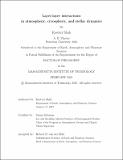Layer-layer interactions in atmospheric, cryospheric, and stellar dynamics
Author(s)
Shah, Kasturi
DownloadThesis PDF (57.52Mb)
Advisor
Solomon, Susan
Terms of use
Metadata
Show full item recordAbstract
Layer-layer interactions comprise some key scientific unknowns and uncertainties in regional and large-scale planetary climate models. My dissertation studies their behaviour with an aim to develop explanations for and improve representations of observed phenomena. I focus on three different systems: stratosphere-troposphere coupling, ice-sediment mechanics, and turbulence in velocity-layered stellar interiors.
Three distinct manifestations of stratosphere-troposphere coupling are studied in this dissertation. First, evidence suggests that ozone depletion has driven changes in southern hemisphere tropical tropospheric width, motivating study of the width of the stratospheric tropics and potential metrics. In the second chapter, directly measured chemical tracers form a useful basis for stratospheric tropical width estimates and two new tracer-based metrics are developed. These metrics are applied to assess relationships between tropospheric and stratospheric width changes and to study stratospheric transport processes.
Second, unanswered questions about the extent of stratospheric modulation and disruptions to it confound efforts to distinguish anthropogenic sources of trace gases, such as continued production that violate the Montreal Protocol, from natural processes. The third chapter studies seasonal synchronizations between the dominant mode of lower stratospheric variability on one-to-five-year timescales and advective contributions to temporal changes in N₂O and CFC-11. These synchronizations influence the abundance of chemical species in the atmosphere from the stratosphere to the surface.
Third, the close association between lower stratospheric temperatures and upwelling facilitate inferring the injection of trace gases and aerosols into the stratosphere. In the fourth chapter, a regional study of the response of lower stratospheric temperatures above the Asian summer monsoon anticyclone is found to obey quasigeostrophic theory. Lower stratospheric monsoon temperatures from both radiosondes and reanalysis have been cooling over the observational record, suggesting enhanced upwelling through the monsoon anticyclone, and increased stratospheric dehydration.
The second system this dissertation focuses on is layered viscous flow. The fifth chapter resents a theoretical and experimental study of two-layer viscous flows on inclined surfaces, commonly found in environmental and industrial flows. The general model reveals a rich variety of flow regimes for different modes of release. These phenomena are likely to underlie more complex examples of layered flows, for which the model and analytical inroads revealed here provide a basis for generalization.
The sixth chapter is motivated by rapid ice flow including icestreams and glacier surge events, which are quasiperiodic fast flow episodes. Mechanisms for surge initiation remain unknown and debated. Here, evidence that many surge-type glaciers are underlain by layers of fine, deformable sediment spurs a stability analysis of the ice-sediment interface. The assessment reveals positive feedback loops and instability mechanisms between the subglacial sediment and overlying ice.
The third layered phenomenon this dissertation addresses is stellar turbulence. Shear-driven turbulence in stratified stellar interiors provides an important source of vertical transport of heat, momentum, and chemical tracers. Motivated by numerical evidence of anisotropic flows, the seventh chapter presents a multiscale analysis that identifies turbulent behaviour regimes.
The eighth and final chapter concludes this dissertation by presenting an outlook and possible directions for future research.
Date issued
2023-02Department
Massachusetts Institute of Technology. Department of Earth, Atmospheric, and Planetary SciencesPublisher
Massachusetts Institute of Technology